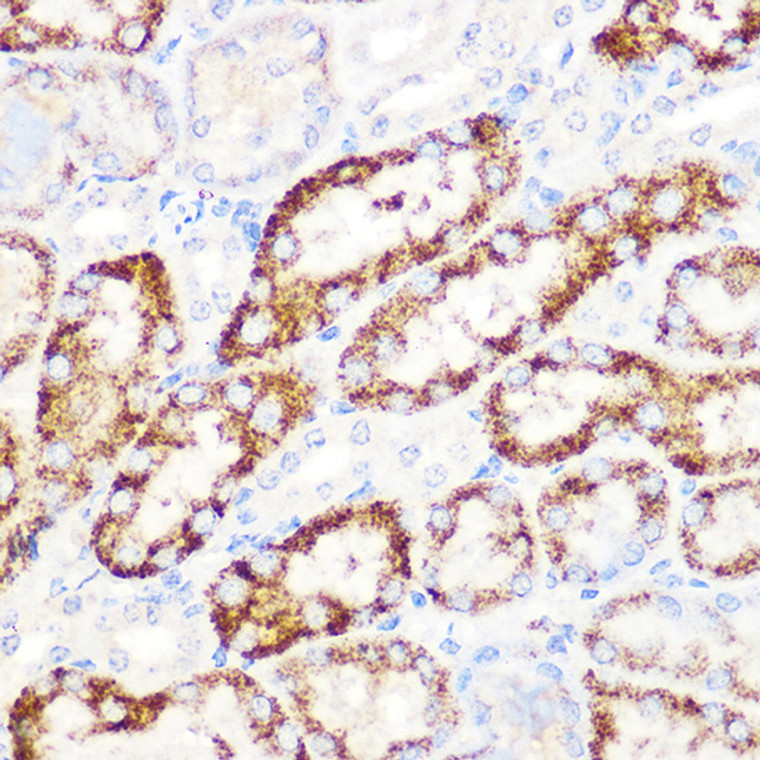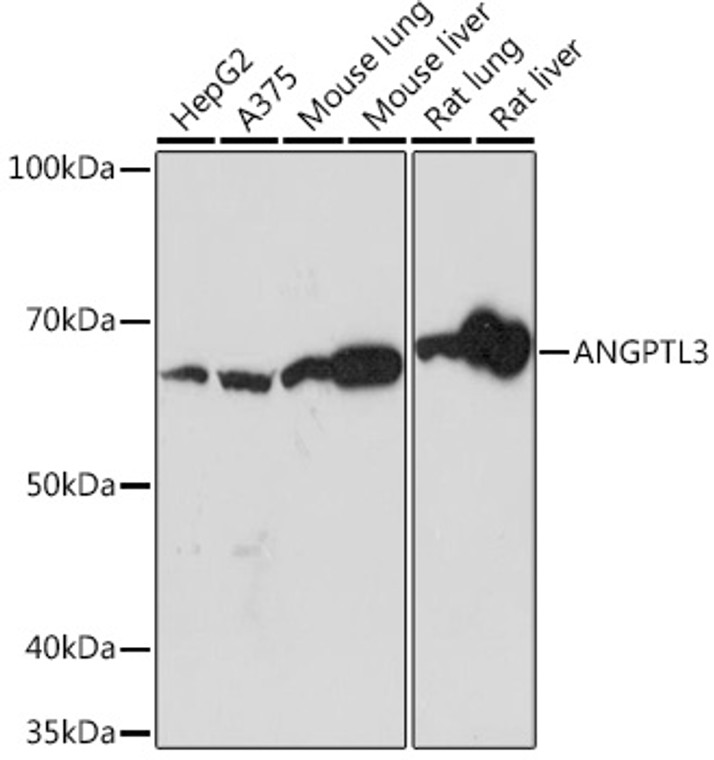| Host: |
Rabbit |
| Applications: |
WB/IHC/IF |
| Reactivity: |
Human/Mouse/Rat |
| Note: |
STRICTLY FOR FURTHER SCIENTIFIC RESEARCH USE ONLY (RUO). MUST NOT TO BE USED IN DIAGNOSTIC OR THERAPEUTIC APPLICATIONS. |
| Short Description: |
Rabbit monoclonal antibody anti-ANGPTL3 (1-100) is suitable for use in Western Blot, Immunohistochemistry and Immunofluorescence research applications. |
| Clonality: |
Monoclonal |
| Clone ID: |
S1MR |
| Conjugation: |
Unconjugated |
| Isotype: |
IgG |
| Formulation: |
PBS with 0.02% Sodium Azide, 0.05% BSA, 50% Glycerol, pH7.3. |
| Purification: |
Affinity purification |
| Dilution Range: |
WB 1:500-1:2000IHC-P 1:50-1:200IF/ICC 1:50-1:200 |
| Storage Instruction: |
Store at-20°C for up to 1 year from the date of receipt, and avoid repeat freeze-thaw cycles. |
| Gene Symbol: |
ANGPTL3 |
| Gene ID: |
27329 |
| Uniprot ID: |
ANGL3_HUMAN |
| Immunogen Region: |
1-100 |
| Immunogen: |
A synthetic peptide corresponding to a sequence within amino acids 1-100 of human ANGPTL3 (Q9Y5C1). |
| Immunogen Sequence: |
MFTIKLLLFIVPLVISSRID QDNSSFDSLSPEPKSRFAML DDVKILANGLLQLGHGLKDF VHKTKGQINDIFQKLNIFDQ SFYDLSLQTSEIKEEEKELR |
| Tissue Specificity | Expressed principally in liver. Weakly expressed in kidney. Binds to adipocytes. Increased expression and colocalization with activated ITGB3 in glomeruli of patients with nephrotic syndrome showing effaced podocyte foot processes (at protein level). |
| Post Translational Modifications | O-glycosylated at Thr-226 by GALNT2.blocks processing and activation by proprotein convertases. In part proteolytically cleaved by proprotein convertases.proposed to be involved in activation. |
| Function | Acts in part as a hepatokine that is involved in regulation of lipid and glucose metabolism. Proposed to play a role in the trafficking of energy substrates to either storage or oxidative tissues in response to food intake. Has a stimulatory effect on plasma triglycerides (TG), which is achieved by suppressing plasma TG clearance via inhibition of LPL activity. The inhibition of LPL activity appears to be an indirect mechanism involving recruitment of proprotein convertases PCSK6 and FURIN to LPL leading to cleavage and dissociation of LPL from the cell surface.the function does not require ANGPTL3 proteolytic cleavage but seems to be mediated by the N-terminal domain, and is not inhibited by GPIHBP1. Can inhibit endothelial lipase, causing increased plasma levels of high density lipoprotein (HDL) cholesterol and phospholipids. Can bind to adipocytes to activate lipolysis, releasing free fatty acids and glycerol. Suppresses LPL specifically in oxidative tissues which is required to route very low density lipoprotein (VLDL)-TG to white adipose tissue (WAT) for storage in response to food.the function may involve cooperation with circulating, liver-derived ANGPTL8 and ANGPTL4 expression in WAT. Contributes to lower plasma levels of low density lipoprotein (LDL)-cholesterol by a mechanism that is independent of the canonical pathway implicating APOE and LDLR. May stimulate hypothalamic LPL activity. ANGPTL3(17-221): In vitro inhibits LPL activity.not effective on GPIHBP1-stabilized LPL. Involved in angiogenesis. Binds to endothelial cells via integrin alpha-V/beta-3 (ITGAV:ITGB3), activates FAK, MAPK and Akt signaling pathways and induces cell adhesion and cell migration. Secreted from podocytes, may modulate properties of glomerular endothelial cells involving integrin alpha-V/beta-3 and Akt signaling. May increase the motility of podocytes. May induce actin filament rearrangements in podocytes implicating integrin alpha-V/beta-3 and Rac1 activation. Binds to hematopoietic stem cells (HSC) and is involved in the regulation of HSC activity probably implicating down-regulation of IKZF1/IKAROS. |
| Protein Name | Angiopoietin-Related Protein 3Angiopoietin-5Ang-5Angiopoietin-Like Protein 3 Cleaved Into - Angptl3(17-221 - Angptl3(17-224 |
| Database Links | Reactome: R-HSA-8963889Reactome: R-HSA-9029558 |
| Cellular Localisation | SecretedCell ProjectionLamellipodiumColocalized With Hspg2 And Activated Itgb3 On Podocytes |
| Alternative Antibody Names | Anti-Angiopoietin-Related Protein 3 antibodyAnti-Angiopoietin-5 antibodyAnti-Ang-5 antibodyAnti-Angiopoietin-Like Protein 3 Cleaved Into - Angptl3(17-221 - Angptl3(17-224 antibodyAnti-ANGPTL3 antibodyAnti-ANGPT5 antibodyAnti-UNQ153 antibodyAnti-PRO179 antibody |
Information sourced from Uniprot.org
12 months for antibodies. 6 months for ELISA Kits. Please see website T&Cs for further guidance










